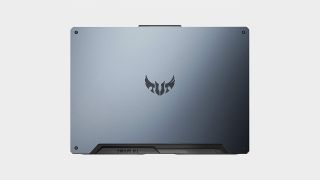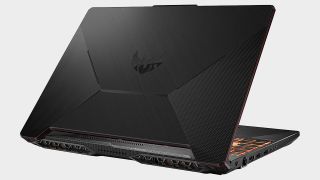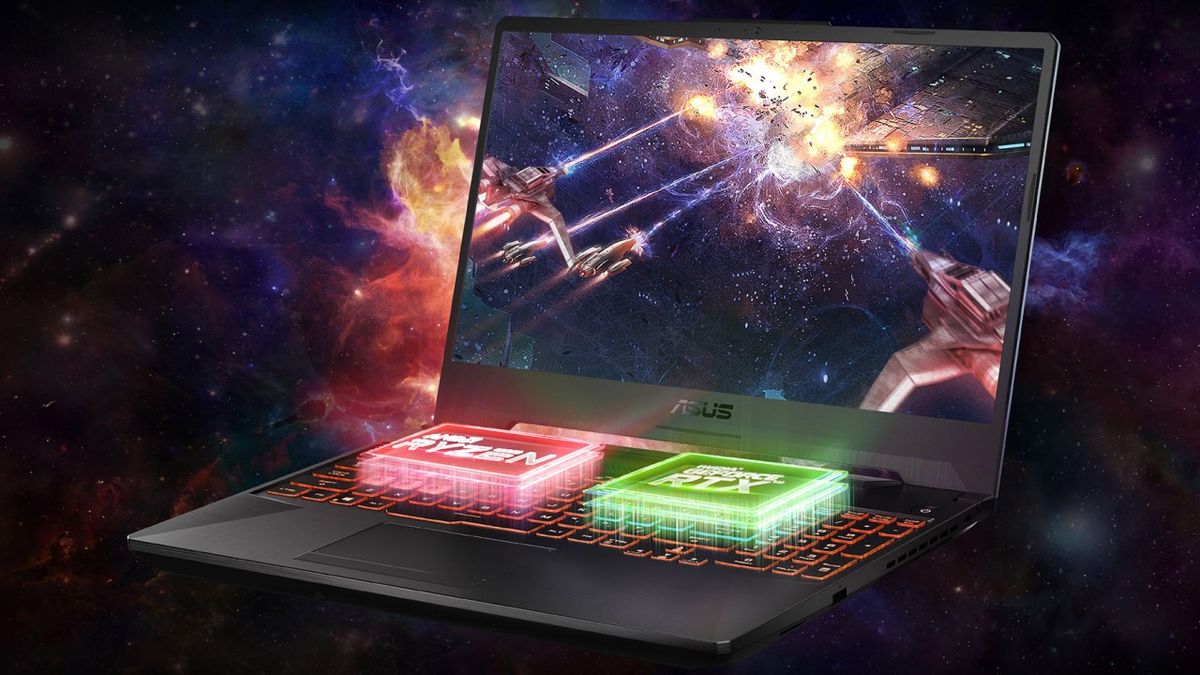12DOVE Verdict
A tremendously successful gaming laptop that offers great value and an entry point into ray tracing. This is a quality machine that will serve you well, whatever your portable needs.
Pros
- +
Great balance of components
- +
Excellent design and build
- +
Strong performance
- +
Good value
Cons
- -
Very loud fans
- -
Sub four-figure ray-tracing laptops are on their way
Why you can trust 12DOVE
Gaming behemoth ASUS makes some of our favorite gaming laptops and some of the best gaming laptops generally, so it's always a pleasure to see what the next one that comes into the (home) office is like. Especially when the premise is so excellent: affordable ray-tracing in a modern, stylish, and very capable laptop. Consider me intrigued, but also optimistic.
Design
Here are the specs for the laptop sent to GamesRadar for review:
Processor: AMD Ryzen 7 4800H
Graphics: Nvidia GeForce RTX 2060 6GB
Memory: 16GB DDR4 3200MHz RAM
Display: 15.6-inch IPS-level 144Hz
Resolution: 1920x1080
Storage: 1TB SSD
Battery: 90Wh
Ports: 2 x Type-A USB 3.2; 1 x Type-A USB2.0; 1 x Type-C USB 3.2 (with display support); 1 x RJ45 LAN ; 1 x HDMI 2.0b 1 x HDMI 2.0b; 1 x 3.5mm headphone and microphone combo jack;
Connectivity: Integrated Wi-FI 5 (802.11ac 2x2) / Bluetooth 5.0
OS: Windows 10 Home 64-bit
Weight: 5.07 pounds (2.3kg)
Straight out of the gate, the TUF A15 reveals the same hallmarks we all know and love from an ASUS laptop. It's got a strong, almost industrial look to it, finished with a brushed metal aesthetic that's very cool and contemporary. It looks like a gaming laptop, yes, but is also restrained enough that you wouldn't mind getting it out in a library. Its chic, angled chassis is very pleasing on the eye and is finished beautifully in gunmetal. It's not super thin, but that's fine - otherwise, the design would start losing ports. I think it's just about right size-wise, too. It treads the line between gamer and hip laptop pretty well.
There are solid screen hinges which offer great stability to the panel, whichever angle you prefer it at, and this contributes to an overall 'robust' design approach; I actually prefer gaming laptops with a bit of weight to them to offset the thin-ness as it gives me confidence that the corners could take a knock or two, and that it could even survive the odd minor accident. The ASUS TUF A15's build certainly nails this.
Elsewhere, there are some dominant cooling vents in the chassis that mean the ports are almost entirely on one side, and the RGB keyboard is slightly soft and quiet, but still satisfying to tap and use, including the slightly slimline numpad. This is a fine addition and very helpful, as laptops that omit this just to save a bit of chassis space suffer for it in my opinion. Finally, a 720p webcam is neatly placed in the frame just above the screen.
Overall, the ASUS TUF A15 has a really terrific design, and one of the sturdiest builds that I've seen on a laptop in a good while.
Features
The most immediately noticeable feature upon first inspection is the screen. In all its anti-glare loveliness, it offers something that is a little more user friendly than the glossy, shiny screens which adorn some portable machines. This anti-glare panel is easy to use for home and work use outside in the sunshine and provides a pleasing quality to a game's picture, too.
A notable feature is the 90wh battery. This is a great addition and will make this a slightly more attractive proposition to those who demand a longer life in their portable powerhouses. Bear in mind, of course, that gaming will always drain the battery and, as such, you're only ever going to get a couple of hours of play before needing to plug it in. That's a worthy trade, though. As I always think with gaming laptops nowadays, we pay to be able to take the laptop between places to game easily, rather than to play games at the highest levels on the go, running purely on battery life. However, the longer battery life generally does add another attractive string to the A15's bow and will appeal to all of those looking for a gaming laptop that can be used for work and home use too allowing for longer, tether-free work sessions.

In terms of ports, you are well served, and the aforementioned design doesn't have to bend over backward too much to accommodate them. Just to lay it out clearly, you have: three USB ports (two 3.2 and one 2.0), one USB-C (that has display support - which is excellent), one HDMI 2.0, one LAN port, and one good old audio jack (of the combo variety). Not sparse by any means, nor over the top; just about what you'd expect from a gaming laptop.
The real stars of the features and specs show are the components themselves: utilizing one of Ryzen's 4000 series processors and teaming it with an Nvidia RTX 2060 card is a really successful move. It harnesses a 'best of both worlds' approach and produces a very nicely balanced and well-performing machine. Supported by 16GB of RAM (which you can upgrade to 32GB down the line if you so wish) and a 1TB SSD in the model I reviewed, the TUF A15 really does have the makings of a much more expensive gaming laptop. However, the neat balance of all the components come together to offer a machine that performs very well, does not break the bank, and sneaks you into glorious ray tracing gaming while it's at it.
Performance
How does the ASUS TUF A15 fare against some industry benchmarks? Here's how it got on with some rigorous gaming tests.
Cinebench CPU: 4,070 cb
3DMark Fire Strike: 14,714 points
3DMark Time Spy: 6,130 points
CrystalDiskMark: 1,676 MB/s read; 1,763 MB/s write
Metro Exodus: RTX (ray-tracing on Ultra): 43 fps; High: 57 fps
Tom Clancy's The Division 2: Ultra: 56 fps; High: 74 fps
Red Dead Redemption 2: Highest: 43 fps; Default: 50 fps
Shadow of the Tomb Raider: Highest: 73 fps; High: 82 fps
Total War: Three Kingdoms: Ultra: 48 fps; High: 66 fps
The meat and potatoes of any gaming laptop, of course, is literally how it plays games. In short, the TUF A15 makes a gaming experience easy, smooth, and fun. As you can see from the benchmark scores we got, the laptop has no trouble with producing excellent framerates. It runs and loads smoothly, too, making everything a pleasant and enjoyable experience overall.
Furnishing you with slightly more detail, and complementing the benchmark scores, it gobbled up Apex Legends incredibly easily. It was a brilliant companion to the speedy, athletic shooter. The speed of the 144Hz screen performed excellently here and heightened the pace and panic in encounters. Meanwhile, the visual fidelity offered in The Division 2 was great - traversing the post-apocalyptic US capital was immensely enjoyable. Although Red Dead Redemption 2 pushed the laptop a little by contrast, the A15 held its own with slightly lowered settings. The Wild West's landscape vistas and busy towns were then vivid and full of life.

It's a good example of how versatile the A15 is. Lowering the settings of games will optimize performance on this laptop even further, accentuating different elements of games and lowering others to ensure smooth performance. While the A15 will handle a great many high settings, lowering them can offer a means to enjoy the 144Hz refresh rate of the screen too.
The screen wasn't as glorious detailed and vibrant given the slight matte quality that the anti-glare panel has, with some images and colors appearing a little dim and pasty at times, but this is slightly nitpicky as the images were clear and enjoyable nonetheless. Whatever you throw at it, the A15 munches through incredibly well and without a hiccup. That's true for watching media too, and it's a joy to use for work. It really is a laptop that performs on every level.
The only major downside of the A15 revealed itself during testing - it can run quite warm, and is very loud in the fan department. I could hear the fans over music and games while listening on headphones, for example. Seriously, you'll need a top PC headset for gaming clamped to your head and cranked up a fair bit to drown out the fans completely. Having said that though, it does go back to normal relatively quickly, even in the unrelenting hot weather we're having over here in the UK. It's not a massive fault or eyebrow-raiser in and of itself - all gaming laptops blow hard at some point - and it does not hold

Save up to 60% off Bitdefender Total Security antivirus
Bitdefender's security packages currently sit on top of our best antivirus guides and there's never been a better time to buy thanks to the massive discounts. In the US you can save 60% on the annual security bundles with prices starting at just $23.99 a year. In the UK 54% discounts see the prices starting at a mere £17.99.
Overall - should you buy it?
With a price tag of only $1,300 / £1,300, this is a great laptop and one of the best gaming laptops of 2020 for sure. ASUS laptops are often easy to recommend, but this is the most straightforward recommendation to make that I have ever had the opportunity to offer. Even with sub-four figure ray tracing-capable laptops coming sometime this year, this is still a great machine, harnessing all the greatness of well-chosen AMD and Nvidia components. It proves that excellence can be achieved in the realm of 'cheap gaming laptops' - at least in relation to the bang-to-buck value. The TUF A15 oozes that. If you're after performance and power for less, then this is it.
Rob is the Deputy Editor of sister site, TechRadar Gaming, and has been in the games and tech industry for years. Prior to a recent stint as Gaming Editor at WePC, Rob was the Commissioning Editor for Hardware at 12DOVE, and was on the hardware team for more than four years, since its inception in late 2018. He is also a writer on games and has had work published over the last six years or so at the likes of Eurogamer, RPS, PCGN, and more. He is also a qualified landscape and garden designer, so does that in his spare time, while he is also an expert on the virtual landscapes and environments of games and loves to write about them too, including in an upcoming book on the topic!

Cyberpunk 2 associate game director reveals his greatest development secret: 10 hour loops of music like "Epic Sax Guy" that "gives me insane focus and clarity"

After hitting 500,000 copies sold and nearly 24,000 reviews on Steam, viral $13 horror game Mouthwashing is coming to consoles this year

"A really sad day for speedrunning": The world's fastest gamers brace for a new Twitch storage limit on "all highlights and uploads"
Most Popular





